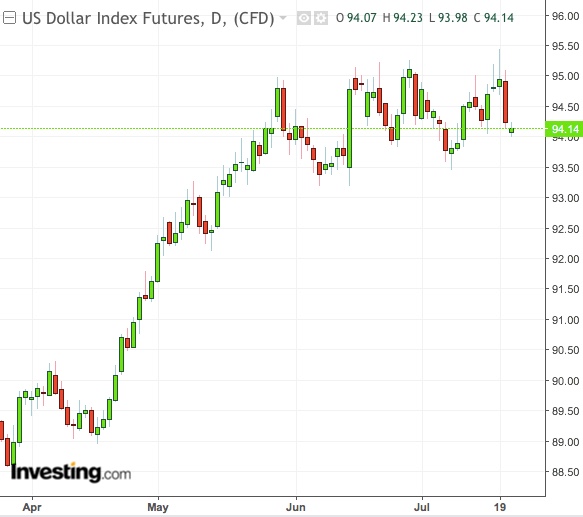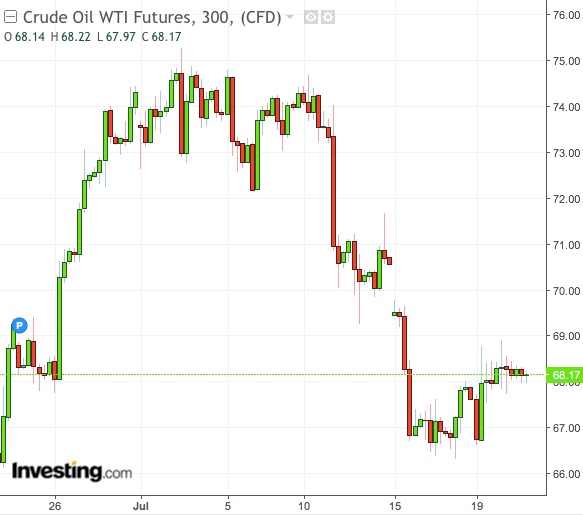Last Friday's unexpected tumble in the dollar may be a precursor to further USD declines that could lift energy, metals and agricultural futures this week, putting non-currency fundamentals to greater test.
With nearly all of the world’s major commodities priced in the dollar, the currency arguably wields more influence than warranted in their market direction: i.e. a stronger dollar equals weaker demand for raw materials, and vice versa. While a natural resource’s price is determined by manufacturers, consumers and investors’ need for it versus supply, the dollar’s relative strength/weakness against the euro and yen often distorts the picture. The ongoing US trade war with China and Europe is creating another anomaly for commodity prices, keeping things like copper below fair value, said analysts at Citigroup.
After hitting one-year highs on Thursday, the dollar index, measured against a basket of six major currencies, ended the week with its biggest one-day drop since June 29. Commodity prices went the other way, with US crude oil, copper, gold and corn futures rising between 1% and 2% each on the day, though most ended the week lower from sharp losses registered earlier in the week.
The dollar slumped after Donald Trump told CNBC he wasn’t thrilled with the Federal Reserve raising interest rates and hurting US exports with a stronger dollar. The president also threatened in that interview to slap tariffs on all $505 billion in Chinese goods imported to the US, beyond his initial threat to cover just over $200 billion of products. He then followed up with tweets that accused China and the European Union of currency and interest-rate manipulation that disadvantaged the US
While Trump was the first president in a quarter century to censure the Fed on monetary policy, he wasn’t the first to finger Beijing for alleged manipulation over rates (Obama did too). And China’s historically evasive response to such accusations indicates he won’t be the last White House occupant to vent over this.
If so, why did forex traders fret and dump the dollar on his remarks?
Long-Due Dollar Correction

Some currency watchers said the dollar moved down partly because of a long due correction on its three-month rally, and Trump’s comments merely provided sellers with a cover.
The downtrend could continue this week, they added.
“The dollar could fall anyway because of profit taking,” Fawad Razaqzada, forex.com’s London-based currency chartist, wrote in a pre-weekend commentary. “A hawkish Fed and two rate rises this year might already be priced in.”
Razaqzada said his technical charts for the dollar index and USD/JPY show bearish-looking candlestick patterns with resistance levels of 95.50 and 113.00, respectively, on a daily basis, and unless they change, “these patterns point to short-term pullback.”
Investing.com’s daily Fibonacci readings have a “neutral” call on the dollar index and a “sell” on USD/JPY. For the dollar index, the pivot emerges at 95.02, and first resistance at 95.31, second at 95.50 and third at 95.79. For USD/JPY, the pivot was at 111.81, and resistance from 112.28 to 112.58 to 113.05.
Even without a slide, the dollar could have an eventful week, with German and European manufacturing PMI, European Central Bank news conference and US home sales and durable data all on the calendar. The most important figure – US Q2 GDP – isn’t due until Friday, making it a particularly vulnerable time for those holding dollars.
Bullion Proxy For Dollar Bears
For commodities, Razaqzada draws attention particularly to bullion and silver, the proxy bet for dollar bears.
While investing.com’s daily technical reading for US gold advocated a “strong sell”, support wasn’t far away at $1,230.94 an ounce – less than a dollar below Friday’s last trade of $1,231.90. For silver, first support was at $15.508 an ounce versus last week’s final print of $15.517.
“As the shorts take profit following hefty falls of late, bargain hunters might find the (precious) metals attractive at these levels,” Razaqzada added.

Not all are confident about gold though. Paris-based investment bank BNP Paribas last week cut its forecast for 2019 to $1,100 an ounce, lower than the $1,250 it had given for this year.
Phillip Streible, senior market analyst at Chicago brokerage RJO Futures, said that while he liked the idea of buying US gold futures for October at $1,250 calls, he wasn’t sure when the yellow metal would recover. “Trump’s comments are not going to stop the Fed from raising interest rates,” he added.
Supply Hurting oil; Agricultural Trades in Play
In oil, worries over increased global supply are likely to face off with positive sentiment from any dollar weakness.
The Latest figures from the Vienna-based Organization of the Petroleum Exporting Countries showed Saudi output in June rose to levels not seen since 2016. In the US, oil production reached 11 million barrels per day for the first time last week as the country has added nearly 1 million bpd in production since November, thanks to rapid increases in shale drilling.

The US West Texas Intermediate and UK Brent crude contracts logged their third straight weekly loss last week, despite gaining from the dollar’s tumble on Friday.
Agricultural markets may be better poised to benefit from USD’s decline, according to Boynton Beach, Florida-based Hackett Financial Advisors, which closely follows the sector.
“We think that by August, the (dollar’s) top will be complete and lead to an accelerated move down into fall, adding a bullish tail wind to ag commodity markets,” said Shawn Hackett, founder and lead analyst for the advisory. “This is further supported by a smart money buy signal in the key commodity currencies algorithm.”
Hackett’s favorite picks for near-term agricultural winners include wheat, coffee, sugar and lean hogs.
